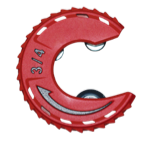The Basics of Repairing Aged CPVC Pipe
As with any aging process, CPVC plumbing pipe that has been functioning for years can change in appearance with the passage of time. Discoloration can happen, but if the pipe is FlowGuard® CPVC, that will not affect the life expectancy of the piping system or its pressure bearing capabilities under normal use conditions.
However, there is a misconception that older CPVC pipe is hard to repair. This is not the case, if the pipe is handled with care and the right tools are used. Simply follow these steps and review the day’s work after each shift to ensure the best repair possible:
- Dry the system out to get residual water out of the joint. Make sure that dirt has been wiped away with a clean cloth. Also scrape or sand off any paint that is adhered to the pipe. Old paint will interfere with the solvent welding process and/or overstress the fitting, possibly causing it to crack.
- Verify that you have a proper interference fit by inserting the pipe easily 1/3 – 2/3 of the depth into the fitting, as you would with a new installation. It’s this critical area that will provide 80% of your joint strength.
 Make a clean, square cut using only a C-style tubing cutter (shown at right), a wheel cutter or a fine-tooth saw, not a ratchet or scissors-style cutter. This is the way to provide the largest surface for a strong solvent cement bond.
Make a clean, square cut using only a C-style tubing cutter (shown at right), a wheel cutter or a fine-tooth saw, not a ratchet or scissors-style cutter. This is the way to provide the largest surface for a strong solvent cement bond.- Chamfer and deburr the pipe to prevent its sharp square edge and/or the cutting debris from scraping too much of the cement off the surface of the socket. This helps to avoid creating a leak path through the joint.
- Check again that the joint is dry before continuing with the usual solvent cement process. Apply the solvent cement to the CPVC fitting and pipe with a dauber, then quickly quarter-turn the pipe into the fitting to evenly spread the solvent.
- Be vigilant by solvent cementing each joint as it is installed. Errors can occur when the system is not installed joint by joint. There should be a bead of yellow solvent cement on each joint.
- Follow the solvent cement manufacturer’s recommendation for set and cure times.
Whether it’s a new install or a needed repair, always keep in mind that when joined correctly with solvent cement, the molecules of FlowGuard® CPVC pipe and fittings are mingled and bond together, with the resultant joint becoming the strongest part of the piping system. That’s the peace of mind that comes from a combination of piping material advances and superior plumber workmanship!
.png)
-1.png)
